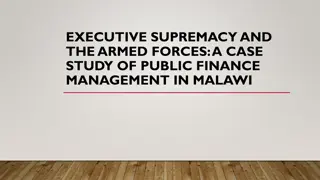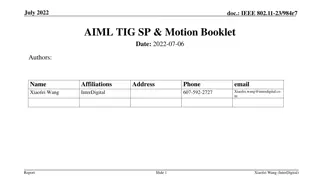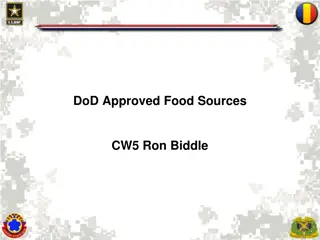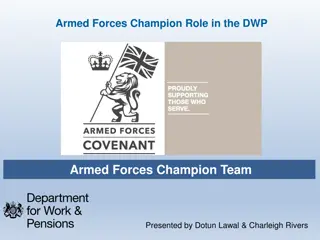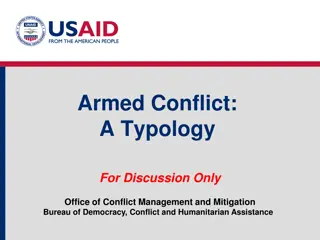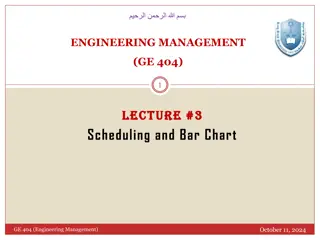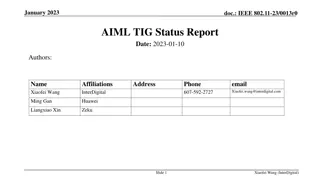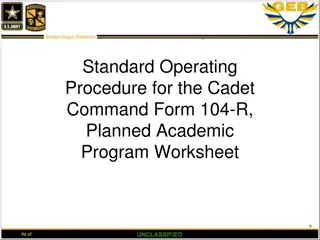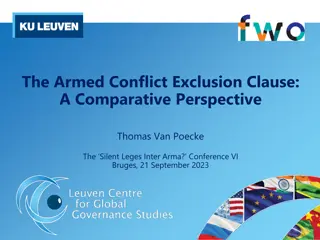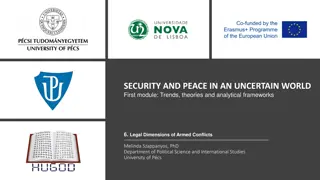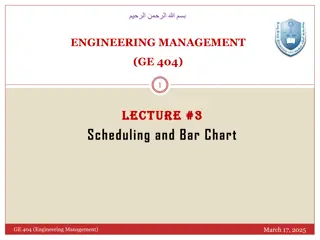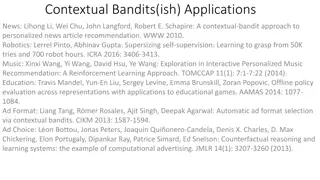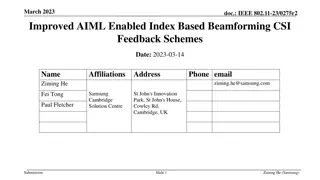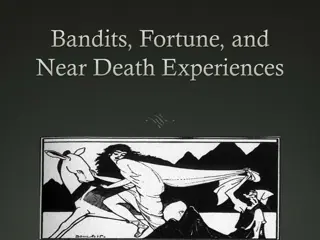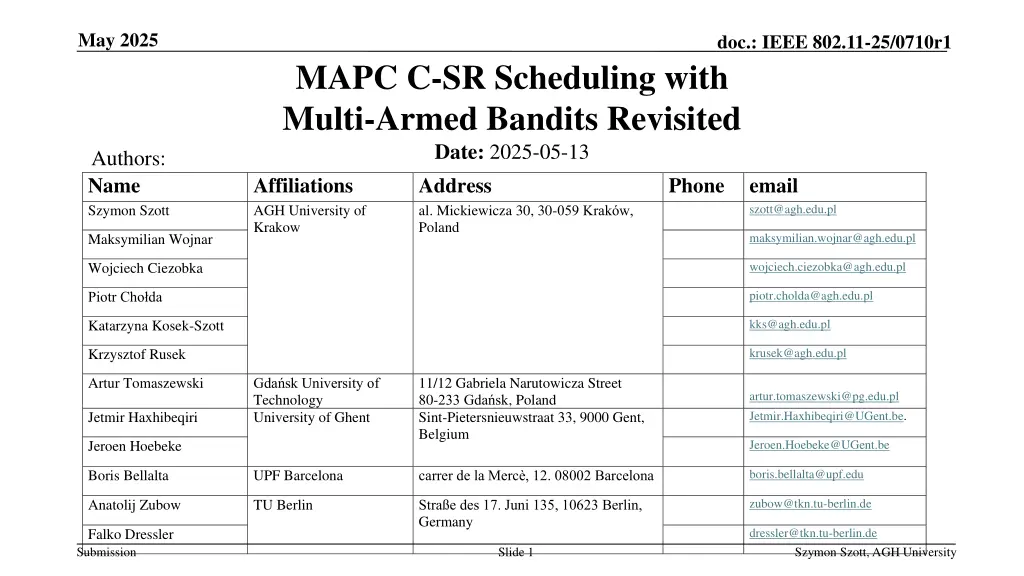
IEEE 802.11-25/0710r1: Co-SR Scheduling with Multi-Armed Bandits Revisited
Dive into the advancements in Co-SR (Coordinated Spatial Reuse) through the lens of reinforcement learning and the complexities of AP selection and transmission configurations. Explore the implications for dense deployments and multi-AP coordination in wireless networking.
Uploaded on | 1 Views
Download Presentation

Please find below an Image/Link to download the presentation.
The content on the website is provided AS IS for your information and personal use only. It may not be sold, licensed, or shared on other websites without obtaining consent from the author. If you encounter any issues during the download, it is possible that the publisher has removed the file from their server.
You are allowed to download the files provided on this website for personal or commercial use, subject to the condition that they are used lawfully. All files are the property of their respective owners.
The content on the website is provided AS IS for your information and personal use only. It may not be sold, licensed, or shared on other websites without obtaining consent from the author.
E N D
Presentation Transcript
May 2025 doc.: IEEE 802.11-25/0710r1 MAPC C-SR Scheduling with Multi-Armed Bandits Revisited Date: 2025-05-13 Affiliations Address AGH University of Krakow Poland Authors: Name Szymon Szott Phone email szott@agh.edu.pl al. Mickiewicza 30, 30-059 Krak w, maksymilian.wojnar@agh.edu.pl Maksymilian Wojnar wojciech.ciezobka@agh.edu.pl Wojciech Ciezobka piotr.cholda@agh.edu.pl Piotr Cho da kks@agh.edu.pl Katarzyna Kosek-Szott krusek@agh.edu.pl Krzysztof Rusek artur.tomaszewski@pg.edu.pl Jetmir.Haxhibeqiri@UGent.be. Artur Tomaszewski 11/12 Gabriela Narutowicza Street 80-233 Gda sk, Poland Sint-Pietersnieuwstraat 33, 9000 Gent, Belgium Gda sk University of Technology University of Ghent Jetmir Haxhibeqiri Jeroen.Hoebeke@UGent.be boris.bellalta@upf.edu zubow@tkn.tu-berlin.de dressler@tkn.tu-berlin.de Jeroen Hoebeke Boris Bellalta UPF Barcelona carrer de la Merc , 12. 08002 Barcelona Anatolij Zubow TU Berlin Stra e des 17. Juni 135, 10623 Berlin, Germany Falko Dressler Submission Slide 1 Szymon Szott, AGH University
May 2025 doc.: IEEE 802.11-25/0710r1 Abstract TGbn is developing Co-SR (Coordinated Spatial Reuse), a variant of MAPC (Multi-AP Coordination). Co-SR configuration (AP selection etc.) remains an open challenge. We apply reinforcement learning to learn best Co-SR configurations. This solution is related to the AIML TIG Technical Report use case for MAPC. Significant extension of previous AIML SC presentation [1]. Detailed explanation of all results in preprint [2]. Code available as open source [3]. Submission Slide 2 Szymon Szott, AGH University
May 2025 doc.: IEEE 802.11-25/0710r1 Background Fully random access insufficient for dense deployments TGbn is introducing multi-AP coordination (MAPC) w/ several modes: Coordinated Spatial Reuse (Co-SR), Coordinated Beamforming (Co-BF), etc. TGbn SFD [4] "TGbn defines a multi-AP Coordinated Spatial Reuse (Co-SR) at TXOP-level with power control." "A sharing AP that intends to initiate a Coordinated Spatial Reuse transmission shall transmit a Trigger frame to initiate concurrent Co-SR transmissions with one (whether to allow more is TBD) other AP within its obtained TXOP." In Co-SR, APs transmit simultaneously, on the same channel, with adjusted Tx power to avoid interference Co-SR != 802.11ax OBSS_PD SR Submission Slide 3 Szymon Szott, AGH University
May 2025 doc.: IEEE 802.11-25/0710r1 C-SR Example Downlink Omnidirectional antennas Tx power levels omitted for clarity Submission Slide 4 Szymon Szott, AGH University
May 2025 doc.: IEEE 802.11-25/0710r1 Problem Statement 1. Which APs should transmit? 2. Which STAs can be the receivers? 3. What should be the TX power levels? Selecting such transmission configurations is the C-SR scheduling problem. Submission Slide 5 Szymon Szott, AGH University
May 2025 doc.: IEEE 802.11-25/0710r1 Solutions Measurements: RSS or CSI Problems Measurements needed between each pair of devices (scalability issues) RSS overhead RSS measurements at STAs from AP beacons, need to be reported upstream RSS unreliability high variance CSI even more overhead, more processing power, frame exchange between AP and non-associated STAs Alternative: probing-based approach Try-and-find out what works No extra signalling Similar problem: rate selection Many measurement-based solutions proposed Current solutions (e.g., Minstrel) are probing-based Submission Slide 6 Szymon Szott, AGH University
May 2025 doc.: IEEE 802.11-25/0710r1 Our Proposal MABs Machine learning (ML) bandits (MABs) MABs No a priori knowledge Online learning Adaptable to randomness of 802.11 topologies Research questions How quickly can MABs learn which C-SR transmission configurations to use? How close to optimal are the transmission configurations found? Reinforcement learning (RL) Multi-armed Submission Slide 7 Szymon Szott, AGH University
May 2025 doc.: IEEE 802.11-25/0710r1 Flat and Hierarchical MABs for Co-SR Traditional (flat) MABs: each configuration is an independent action Configuration = {transmitting APs, recipient STAs, tx power levels} Explosion of no. actions exploration becomes time-consuming Hierarchical MAB architecture reduces the large search space [5] Level 1 agents select APs Level 2 agents select STAs Level 3 agents select TX power levels Submission Slide 8 Szymon Szott, AGH University
May 2025 doc.: IEEE 802.11-25/0710r1 H-MABs Diagram for 2 levels [6] Since then, we ve added a 3rd level (TX power selection) Run the selected Co-SR transmission pairs to obtain reward (i.e., the effective data rate) Submission Slide 9 Szymon Szott, AGH University
May 2025 doc.: IEEE 802.11-25/0710r1 Simulation Setup Baselines DCF SR Upper bounds (cf slide 19) Throughput: T-Optimal Fairness: F-Optimal Our proposals MABs H-MABs Frequency reuse = 1 Submission Slide 10 Szymon Szott, AGH University
May 2025 doc.: IEEE 802.11-25/0710r1 Transient Performance Rapid convergence Effective data rate H-MAB > MAB Impact of nomadic mobility Both MABs quickly converge Submission Slide 11 Szymon Szott, AGH University
May 2025 doc.: IEEE 802.11-25/0710r1 Steady-State Performance H-MABs significantly outperform MABs and baselines Except 3x4 and 4x4 mulit-room topologies Throughput distribution in 2x3 multi-room topology Fairness-throughput tradeoff Submission Slide 12 Szymon Szott, AGH University
May 2025 doc.: IEEE 802.11-25/0710r1 Benefits of Clusterization For the 3x4 and 4x4 multi- room topologies Separate agent in each cluster Clustered versions show much better performance Also in terms of convergence times Submission Slide 13 Szymon Szott, AGH University
May 2025 doc.: IEEE 802.11-25/0710r1 Symmetrical Enterprise Scenario Inspired by TGax enterprise scenario Best-case topology for Co-SR In 4x4, MABs close to both optimal baselines Submission Slide 14 Szymon Szott, AGH University
May 2025 doc.: IEEE 802.11-25/0710r1 Random Open Space Topologies Topology change halfway through the simulation Both MABs better than DCF on average by 80% Only H-MABs consistently outperform DCF Submission Slide 15 Szymon Szott, AGH University
May 2025 doc.: IEEE 802.11-25/0710r1 Impact of Legacy Devices 2x2 multi-room topology Uniformly add legacy (non- Co-SR) APs to contend with one of the four Co-SR Aps Effective data rate when one of the Co-SR APs wins channel access Collisions cause performance deterioration Still gains wrt DCF and SR Submission Slide 16 Szymon Szott, AGH University
May 2025 doc.: IEEE 802.11-25/0710r1 Experimental Testbed openwifi [7] Linux mac80211 compatible full-stack IEEE802.11/Wi-Fi design based on SDR Supports MAPC [8] Network controller sends transmission configurations to APs Each AP has two STAs Near and far MAB/H-MAB hyperparameters optimized in testbed s digital-twin Submission Slide 17 Szymon Szott, AGH University
May 2025 doc.: IEEE 802.11-25/0710r1 Experimental Validation Despite symmetric topology, varying TX success probability STA 2 has worse channel conditions Receives fewer TXOPs No less than under perferctly fair RR Rapid convergence Small topology so flat MABs slightly outperform H-MABs Submission Slide 18 Szymon Szott, AGH University
May 2025 doc.: IEEE 802.11-25/0710r1 Bonus: Upper Bound Model To assess the upper bound of Co-SR operation, we develop a MILP optimization model [2] Based on the column generation optimization method Maximizes a) Aggregate network throughput Co-SR TXOPs typically allocated to best-placed STAs OR b) Fairness maximize throughput of least served STA (max-min optimization) Independent of MABs can be used for any Co-SR setting as a baseline Python code available [3] Submission Slide 19 Szymon Szott, AGH University
May 2025 doc.: IEEE 802.11-25/0710r1 Conclusions on H-MABs for Co-SR Good performance (high throughput, low convergence time for small and medium-sized networks) Resilience to abrupt topology changes and legacy STAs Large-scale networks require clusterization Easy to deploy in hardware (lightweight, no training) Future work Joint MCS selection Fully distributed operation Dynamic cluster selection Larger dynamics (station churn, non-full buffers) coldspares approach Applying a similar probing-based approach for Co-BF Submission Slide 20 Szymon Szott, AGH University
May 2025 doc.: IEEE 802.11-25/0710r1 References [1] S. Szott et al. "MAPC C-SR Scheduling with Multi-Armed Bandits", IEEE 802.11-24/0640r1. [2] M. Wojnar et al. "Coordinated Spatial Reuse Scheduling With Machine Learning in IEEE 802.11 MAPC Networks", arXiv preprint, http://arxiv.org/abs/2505.07278, accessed on 2025-05-13. [3] Coordinated Spatial Reuse Scheduling with Machine Learning in IEEE 802.11 MAPC Networks, https://github.com/ml4wifi-devs/csr, accessed on 2025-05-05. [4] Ross Jian Yu, "Specification Framework for TGbn", IEEE 802.11-24/0209r14. [5] L.-H. Shen, Y. Ho, K.-T. Feng, L.-L. Yang, S.-H. Wu, and J.-M. Wu, Hierarchical Multi-Agent Multi- Armed Bandit for Resource Allocation in Multi-LEO Satellite Constellation Networks, in 2023 IEEE 97th Vehicular Technology Conference (VTC2023-Spring), 2023, pp. 1 5. [6] M. Wojnar et al., "IEEE 802.11bn Multi-AP Coordinated Spatial Reuse With Hierarchical Multi-Armed Bandits," in IEEE Communications Letters, vol. 29, no. 3, pp. 428-432, March 2025, doi: 10.1109/LCOMM.2024.3521079. [7] openwifi, https://github.com/open-sdr/openwifi, accessed on 2025-05-05. [8] J. Haxhibeqiri et al. "Bringing time-sensitive networking to wireless professional private networks: Filling gaps and bridging the innovation." Wireless Personal Communications 121 (2021): 1255-1271. Submission Slide 21 Szymon Szott, AGH University


